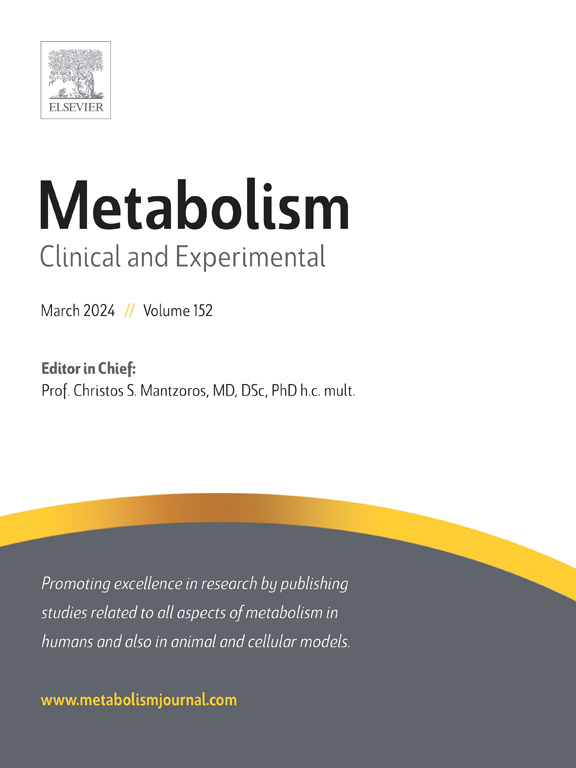载脂蛋白C-III抑制剂治疗高甘油三酯血症:随机对照试验的荟萃分析
IF 10.8
1区 医学
Q1 ENDOCRINOLOGY & METABOLISM
引用次数: 0
摘要
导论:高甘油三酯血症与动脉粥样硬化性心血管风险和胰腺炎风险相关。载脂蛋白C-III (APOC-III)抑制剂的有效性和安全性尚不清楚。目的:探讨APOC-III抑制剂对高甘油三酯血症及其并发症的影响。方法:我们系统地检索PubMed, Embase和Cochrane Central数据库,从建立到2024年5月,比较APOC-III抑制剂和安慰剂对高甘油三酯血症患者的随机对照试验(rct)。我们分别汇总了连续和二元结果的标准化平均差(SMD)变化百分比和风险比(RR),置信区间(CI)为95% %。对APOC-III抑制剂药物剂量(Olezarsen、Volanesorsen和plzasiran)以及原发性和继发性高甘油三酯血症进行亚组分析。结果:纳入10项随机对照试验,1204名受试者,其中46% %为男性。APOC-III抑制剂显著降低甘油三酯(TG) (SMD: -60.56 %;95 % CI -68.94 ~ -52.18;p 结论:APOC-III抑制剂改善TG水平和其他脂质面板参数,并减少原发性和继发性高甘油三酯血症患者的急性胰腺炎发作。本文章由计算机程序翻译,如有差异,请以英文原文为准。
Apolipoprotein C-III inhibitors for the treatment of hypertriglyceridemia: a meta-analysis of randomized controlled trials
Introduction
Hypertriglyceridemia is related to atherosclerotic cardiovascular risk and pancreatitis risk. The efficacy and safety of apolipoprotein C-III (APOC-III) inhibitors remains unclear.
Aim
To investigate the effects of APOC-III inhibitors on hypertriglyceridemia and its complications.
Methods
We systematically searched PubMed, Embase, and Cochrane Central databases from inception to May 2024 for randomized controlled trials (RCTs) comparing APOC-III inhibitors to placebo in patients with hypertriglyceridemia. We pooled percentage standardized mean difference (SMD) changes and risk ratio (RR) for continuous and binary outcomes, respectively, with 95 % confidence interval (CI). Subgroup analyses were performed with APOC-III inhibitors drugs doses (Olezarsen, Volanesorsen and Plozasiran), and primary and secondary hypertriglyceridemia.
Results
10 RCTs with 1204 participants were included, of which 46 % were men. APOC-III inhibitors significantly reduced triglycerides (TG) (SMD: −60.56 %; 95 % CI −68.94 to −52.18; p < 0.00001), APOC-III (SMD: −75.44 %; 95 % CI −80.81 to −70.07; p < 0.00001) and non-HDL-c (SMD: −27.49 %; 95 % CI −34.16 to −20.82; p < 0.00001) levels. Consistent results were found for all subgroup analyses. APOC-III inhibitors were capable to normalize TG levels in patients with severe hypertriglyceridemia (RR: 7.92; 95 % CI 4.12 to 15.23; p < 0.00001). There was a significant increase in HDL-c (SMD: 43.92 %; 95 % CI 37.27 to 50.57; p < 0.00001) and LDL-c (SMD: 33.05 %; 95 % CI 9.08 to 57.01; p = 0.007) levels. There was a significant relative risk reduction in acute pancreatitis in the APOC-III inhibitors group (RR 0.17; 95 % CI 0.05 to 0.53; p = 0.007). Adverse events were similar in both groups.
Conclusion
APOC-III inhibitors improve TG levels and other lipid panel parameters, as well as reduce episodes of acute pancreatitis in patients with primary and secondary hypertriglyceridemia.
求助全文
通过发布文献求助,成功后即可免费获取论文全文。
去求助
来源期刊

Metabolism: clinical and experimental
医学-内分泌学与代谢
CiteScore
18.90
自引率
3.10%
发文量
310
审稿时长
16 days
期刊介绍:
Metabolism upholds research excellence by disseminating high-quality original research, reviews, editorials, and commentaries covering all facets of human metabolism.
Consideration for publication in Metabolism extends to studies in humans, animal, and cellular models, with a particular emphasis on work demonstrating strong translational potential.
The journal addresses a range of topics, including:
- Energy Expenditure and Obesity
- Metabolic Syndrome, Prediabetes, and Diabetes
- Nutrition, Exercise, and the Environment
- Genetics and Genomics, Proteomics, and Metabolomics
- Carbohydrate, Lipid, and Protein Metabolism
- Endocrinology and Hypertension
- Mineral and Bone Metabolism
- Cardiovascular Diseases and Malignancies
- Inflammation in metabolism and immunometabolism
 求助内容:
求助内容: 应助结果提醒方式:
应助结果提醒方式:


